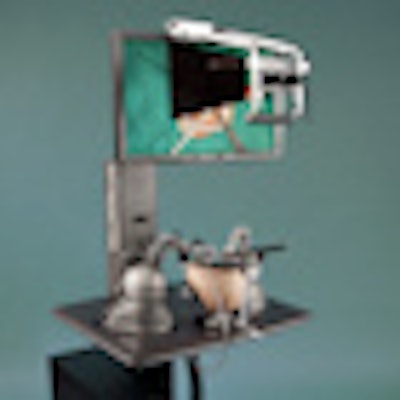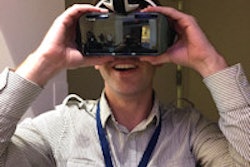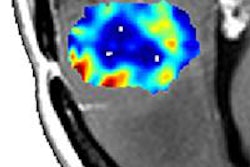
Canadian researchers have developed a virtual reality simulator that makes use of 3D image reconstructions and haptic technology to enable neurosurgery trainees to simulate and practice brain cancer surgery.
Called NeuroTouch, the system simulates what the neurosurgeon sees through the operating microscope during surgery. It features a 3D graphics rendering system, a bimanual haptic rendering system, other controls, and one or two computers.
"Training on patients will probably always be a part of surgical education, but surgical simulators can help introduce junior residents to basic surgical techniques before they first operate on a patient," said Sébastien Delorme, PhD, of the National Research Council Canada, which developed the system.
 NeuroTouch allows neurosurgery trainees to simulate brain surgery via 3D graphics and tactile feedback. Image courtesy of the National Research Council of Canada.
NeuroTouch allows neurosurgery trainees to simulate brain surgery via 3D graphics and tactile feedback. Image courtesy of the National Research Council of Canada.
The graphics rendering system and 3D stereoscopic display are designed to mimic the binocular view of a neurosurgical microscope, providing detailed and lifelike rendering of brain tissue, blood vessels, and tumors, according to the researchers. Users receive tactile feedback via haptic tool manipulators, which simulate what the surgeon would actually feel during surgery.
"Brain and tumor tissues in NeuroTouch look and feel like real tissues; they pulsate, they bleed if cut, they can be cauterized with a bipolar [cautery tool] or removed with an ultrasonic aspirator," Delorme told AuntMinnie.com. "NeuroTouch trainees can feel the stiffness of the tissues they touch through real neurosurgical tools mounted on force-feedback handles."
Delorme and colleagues described their initial experience with NeuroTouch in a paper published in the September issue of Neurosurgery.
3D reconstructions of MR images from actual patients were used to develop training tasks to simulate common neurosurgery procedures. For example, one task involved the surgeon removing brain tumor while leaving normal tissue intact using two different suction devices.
A second task involved the surgeon removing a vascularized tumor while controlling blood loss, according to the researchers. After the surgeon uses a cutting tool, the vessels bleed; bleeding is stopped after a simulated cautery tool is applied.
The system can provide an objective and automatic evaluation of a trainee's performance, Delorme said. Residents can also train autonomously on NeuroTouch, and mentors can log in later and check their performance.
"High-level musicians or athletes use daily training to maintain their skills," he said. "This is why several hospitals have chosen to locate their NeuroTouch system near operating rooms or near neurosurgery patient's rooms: so that it is quickly available to any resident."
As described in the Neurosurgery paper, first-generation NeuroTouch prototypes were set up at seven teaching hospitals in Canada. After feedback was collected from these beta sites, the hardware was made more compact and ergonomic, Delorme said.
In addition, the group improved the realism of the software engine and significantly increased the educational content on the system. Since the paper was submitted, several new training scenarios have also been added, including endoscopic third ventriculostomy simulation, he said.
In early 2012, the team began deployment of second-generation NeuroTouch simulators at six teaching hospitals in North America.
"Some of the Canadian hospitals that helped us from the start of the development recently did a validation study on NeuroTouch, and the results are currently being analyzed," he said.
NeuroTouch training scenarios were also recently demonstrated on IMRIS' NeuroArm robot at the Congress of Neurological Surgeons annual meeting in October, Delorme said. New training scenarios are still being developed, such as endoscopic sinus surgery, lumbar laminectomy, and brain tumor en bloc dissection.
"The use of NeuroTouch could potentially be extended to patient-specific rehearsal through the development of an efficient data-processing pipeline to convert medical images of patients into simulation models," the authors wrote.




















